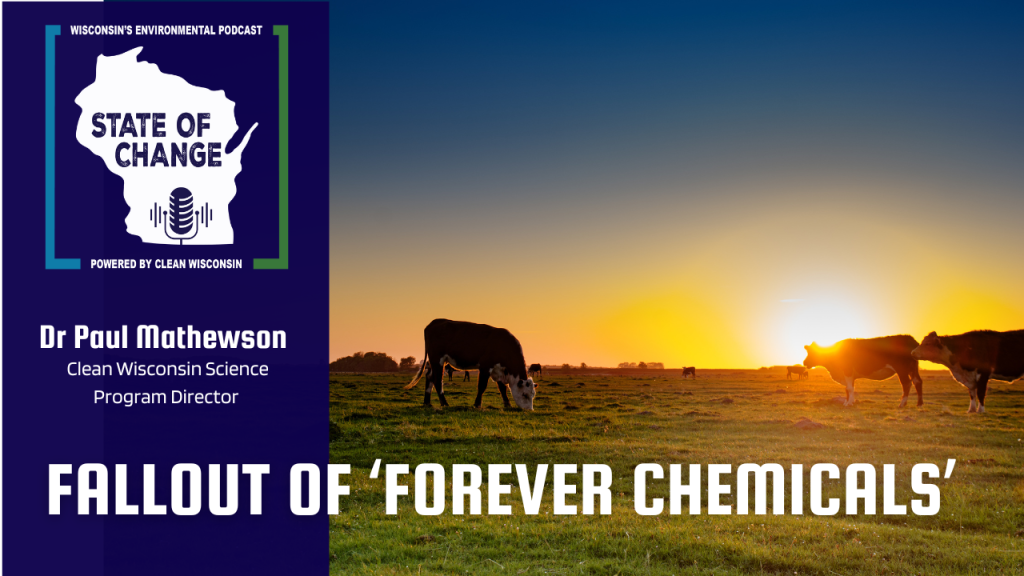It’s no exaggeration to say PFAS ‘forever chemicals’ are everywhere, from our shoes to our pots and pans, to our takeout boxes. Some states have found PFAS tainting their milk and meat and contaminating crops. What are the health consequences of population-wide exposure to these toxic chemicals? Amy talks with Clean Wisconsin Science Program Director Dr. Paul Mathewson about the latest research.
Host:
Amy Barrilleaux
Guest :
Dr. Paul Mathewson, Science Program Director, Clean Wisconsin
Background reading:
- Clean Wisconsin’s comments to the Natural Resources Board on the impact of groundwater PFAS standards
- Find out more about PFAS contamination in Wisconsin
- Read the latest PFAS Fish Consumption Advisories for Wisconsin
- View an interactive map of PFAS contamination sites in Wisconsin
- Study: Leveraging Systematic Reviews to Explore Disease Burden and Costs of Per- and Polyfluoroalkyl Substance Exposures in the United States
Where to Listen:
Like ‘State of Change?’
Subscribe to State of Change on Apple Podcasts, Google Play Music, Spotify, or wherever you get your podcasts.
Be sure to rate our show and give us a review. It helps other people find us.
You can learn more about Clean Wisconsin and our work at www.cleanwisconsin.org
Sign up to get the latest news from Clean Wisconsin in your inbox at www.cleanwisconsin.org/email
Like State of Change? Help support our podcast and our work to protect Wisconsin’s environment at www.cleanwisconsin.org/donate
Transcript
Amy Barrilleaux Frustration in Peshtigo and Marinette, site of the largest known PFAS contamination plume in Wisconsin, after Senate Republicans introduce a PFAS cleanup bill that could make it harder for the state to hold polluters accountable.
“Corporations have made billions of dollars in profits while contaminating our community and communities around Wisconsin. They do not need legislative protection. Citizens do.”
“We’ve talked and we’ve put the message out there with closed ears. We have to stop political favoritism for monetary value. These these corporations are buying our political figures for a dollar fee. And it’s sad.”
Amy Barrilleaux As states like Wisconsin grapple with the high cost of clean up, researchers are putting a price tag on the health care burden that comes with population-wide exposure to these toxic chemicals. In this episode, I’ll talk with Clean Wisconsin Science Program Director Dr. Paul Mathewson about the ways we’re all exposed to forever chemicals and what they could mean for our health. I’m Amy Barrilleaux, and this is State of Change from Clean Wisconsin.
It’s no exaggeration to say that PFAs chemicals are all around us. They’ve been manufactured since the 1940s. And while some types have been phased out, chemical companies are making new ones all the time. They’re in the super-smooth dental floss you used this morning. The cardboard container your takeout food comes in, the comfy chair you like to sit in, your favorite nonstick pan, your shoes, your jacket, the carpet under your feet. Now, researchers are trying to understand what all this widespread use and exposure means for our health. Joining me is Dr. Paul Mathewson, science program director at Clean Wisconsin. These chemicals are frankly very useful. They make products stain proof, nonstick, greaseproof, water resistant. But they are at the center of a lot of concern. Why are they capturing so much attention right now?
Paul Matthewson Yeah, so they are capturing attention for a couple of reasons. One is their ubiquity. They’re everywhere. They have properties that make them very valuable for a number of applications. And so they’re in lots of different products that people use every day. And they’re they’re just everywhere. And so everyone is exposed to them at some level or another. And the other reason they get a lot of attension is because they are toxic at very small levels. And so when they’re setting these levels, you’re talking a drop or two in an Olympic swimming pool. So they’re very toxic. They’re toxic at very low levels. And they have a range of health impacts that right now run from elevated cancer risk to obesity risk to cholesterol issues to immune function, decreased vaccine response. And so it affects the body a number of ways. And they don’t break down. So they they stick around in the environment for a very long time. So as we keep using them, they keep building up in the environment, increasing our exposure risk. So I think those are a lot of the reasons why they’re gaining a lot of attention.
Amy Barrilleaux So what you said was really scary, you know, that we have chemicals, they’re everywhere, and at least some of them are being regulated at these extremely low levels because that’s how hazardous they are. How did we get here? Why are we surrounding ourselves with chemicals that, at least from the ones that have been well studied, show a lot of, you know, concerning things?
Paul Matthewson Yeah, a lot of that is just the way our system is set up here in the United States, where in terms of the approval process for chemicals is not as stringent as perhaps it should be in hindsight. You know, a lot of times it’s – you’ve got to prove it’s dangerous rather than prove it’s safe. We just allowed these chemicals to get out and they, you know, widespread use before we really understood how how impactful they are. Similar to other other toxic compounds that have had useful properties like DDT and pesticides, served a purpose but had significant consequences that we phased out. PCBs that, you know, used in a lot of different products, figured out how bad they are, working on phasing them out. So, you know, it’s not a new story. It’s just this is the newest one, unfortunately.
Amy Barrilleaux And you talked about how these chemicals stick around. So unlike maybe PCBs and DDT, PFAS chemicals are — I mean, what’s happening with, like, hey, I got these new boots, they may have PFAS on them because they’re waterproof. What’s going to happen to these chemicals in these boots?
Paul Matthewson Yeah. So they’ll stick around for a while. And so, you know, as you wear your boots, they’re doing their job protecting your feet outside, but they’re going to start wearing off the waterproofing and the other components, they may have PFAS in it. And that will just stick around the environment for a long time because that that carbon fluorine bond is super strong. And so that’s the hallmark of PFAS compounds is they have a backbone of carbon fluorine and that bond is very, very strong and it takes a very, very long time to degrade. And so that’s why theyy call them forever compounds. And so a lot of other chemicals in compounds, you know, the sun will break them down, bacteria will break them down once they’re exposed to the elements in the outdoors. But PFAS not one of those. And so we keep using them and they’re accumulating environment much faster and they’re breaking down.
Amy Barrilleaux We haven’t phased out PFAS. We phased out, I think two types, the two most well-studied concerning types have been around for decades and decades. Is it surprising to you that PFAS chemicals as a class are still not only out there but they’re still being produced and put into consumer products?
Paul Matthewson Unfortunately, I wouldn’t say it’s surprising. You know, like you said, there are over 5000 different types of them. And so one can make an argument that we don’t know that they’re all toxic as the ones that we’ve studied, because when you talk about the ones that are phased out, they are called eight-carbon PFAS compounds. So they have, you know, their backbone is eight carbons. And so those are on the long end. The newer ones are four-carbon and smaller. And so the idea is that these have less toxic impacts. They cycle through the body faster so they don’t impact us as much. I will say that that I have read some studies that kind of push back on that idea. And so that’s not entirely clear. But unfortunately, it’s not surprising we continue to use it because like I said, again, the way our system is set up, you’ve got to prove something is bad before you can do something about it, rather than having to prove it safe.
Amy Barrilleaux From a scientific perspective. How do you prove that five, six, 7000 different types of chemicals are bad?
Paul Matthewson Yeah, that that’s a big challenge. And so that’s why there, you know, there are calls to regulate as a class. We know that they’re all fairly similar. They are different, they all have different structure, but in essence, you can say they probably act fairly, fairly similar. And so, you know, my opinion is that if we are to actually make a real dent in PFAS, we will have to ultimately regulate them as a class because it’s taken us here in Wisconsin a few years to get regulations on, you know, less than half a dozen PFAS compounds. And we’re talking about expanding that out to thousands. It’s obviously – you can’t do it compound by compound. You’ve got to take an approach of, you know, treating these as a class if you’re going to functionally get to a point where they are regulated to a safe level.
Amy Barrilleaux One of the things that people find shocking about PFAS, these forever chemicals, is that we all have some level of PFAS in our bloodstream because they stick around, particularly the the bigger ones, the longer chain PFAS chemicals. So we’re talking about health impacts. I feel okay. You look all right. Most people have PFAS in their bloodstream and are exposed every single day. Why aren’t we all experiencing these health impacts?
Paul Matthewson I think there’s kind of two parts to that. One is PFAS is one chemical we’re exposed to on top of other ones. And so, you know, we talk about our cumulative pollutant exposure. Other things are ubiquitous, like polycyclic aromatic hydrocarbons, you know, air pollution, all these things that we’re exposed to every day. This is one piece of it. And, you know, it’s a piece that perhaps we can do something about. And so whenever you can do something about one piece of the pollution we’re exposed to, I’d say we should do it. And the other thing with a lot of these things, you know, it’s not acute health impacts. You know, at super high levels, very high levels found in a contamination area, yes, you can have that elevated cancer risk, you can have these acute things. But a lot of these impacts with a lot of environmental pollution, it’s not something you might notice every day. Things like decreased immune function. So you don’t you know, it’s hard to say that I’m feeling this every day, but when you’re exposed to an illness, you may not be able to fight it off as well as you could have if you weren’t exposed to this. And so, you know, even if it’s not an acute thing that you can immediately see and feel the impact of, it doesn’t mean it’s not impacting your health. And particularly with these chemicals and with a lot of environmental contaminants, the ones who are most at risk are developing fetuses and young children because they’re developing so rapidly. When they’re exposed to PFAS compounds and other environmental pollutants, those impacts are much greater and they have longer term impacts. And so when you’re talking about PFAS, the most at risk populations are, you know, pregnant women with the developing fetus because PFAS can cross the placenta and get into the developing fetus and then the young children who are exposed to it.
Amy Barrilleaux So you’ve been looking at a number of health studies that have come out about PFAS, and I think it’s maybe not these acute illnesses that you might associate with something that people are exposed to, but kind of this broad look at our population, we are all exposed to PFAS chemicals. What it is doing to us on this on this bigger scale. So what are we starting to find out from these studies?
Paul Matthewson So the there is a recent study published earlier this year that looked at – they attempted to calculate the impact of the health consequences in the United States of PFAS exposure from two previous compounds, PFOA and PFOA. Those are the 8-chain ones that are most well-studied and have the most evidence of, you know, when you would see impacts, what kind of levels you need to see in your bloodstream to have impacts. And so they looked at five different health endpoints that had good evidence for a really a causal relationship. You know, the strongest scientific evidence that this exposure translates into these problems. And it’s increased childhood obesity, increased cancer risk, decreased thyroid function in women, and there were a couple others in there. The impacts of that are creating health care costs in the US of conservatively about $5 billion a year due to those sublethal impacts on things. You know, just given the ubiquity of these these compounds and the low levels at which they cause these impacts, that’s that’s a huge health burden, conservatively speaking, in the United States, every year. When they expanded out to other health impact health endpoints that don’t have, say, the same strength of scientific evidence that there are causal relationships, but there is still some evidence that’s worthy of considering, that number goes up to $60 billion a year. So these are significant impacts to our public health in the United States.
Amy Barrilleaux This is just taking a look at those two types of compounds that have been phased out. But because they are forever chemicals, they are definitely still with us everywhere. When you look at PFAS as a class, would it even be possible to to study that?
Paul Matthewson No, I have not seen that. So almost every health study I’ve seen has focused on those two compounds. And so I’m guessing the reason why we haven’t seen that as a class yet is at this point, you just can’t do that.
Amy Barrilleaux We have heard of other states that are dairy states that have had some issues with PFAS showing up in in cows, milk. So what is happening there and what are these states that are experiencing that?
Paul Matthewson Yeah, so a couple states they have found PFAS in livestock products, in beef or in milk or in the the feed that they’re feeding for livestock. The states that have looked at this the most are Michigan and Maine. And so in Maine there have been a few different farms where they have, the DNR equivalent over there, have actually done an investigation and they’ve concluded that the source of the PFAS in these farms has been the spreading of industrial sludge is or biosolids which have some nutrients in them, like nitrogen and phosphorus, that is beneficial for crops. And so this is a common practice throughout the United States to spread biosolids or industrial sludges that do have the nutrient value on on farm fields as a way to, you know, a way for the for that stuff to be disposed of and another way for the crops to get the nutrients in in a fairly cheap way. And so unfortunately in these cases there was a dairy farm. He found very high levels in his water that he was feeding to the cows. And so he’s having to milk the cows and just have to dump the milk. You know, thousands of gallons a day is down the drain. Another farm was an organic vegetable farm. They found that they had super high PFAS levels in their soil and they just had to shut down. They couldn’t sell their so their produce. Similarly, there was another example in New Mexico of a dairy farm where they live next to an Air Force base and their groundwater was contaminated. The contamination plume went underneath their farm and their water that they’re feeding their cows was contaminated with PFAS. And so, again, another situation where the farm had to just dump their milk. And other cases where they’ve had to pull meat off shelves, you know, pull milk off the shelves. The case in Michigan, where a beef farm had had elevated PFAS levels in their beef and so just kind of came to a standstill. He couldn’t get rid of the cows, the beef cattle, because you can’t get rid of contaminated cows. But he couldn’t sell his meat either. So he’s kind of in limbo and no direction on what to do on it. So there are these impacts out there.
Amy Barrilleaux Again, what you’re saying is pretty scary. So if we have these chemicals that don’t break down that wind up in air, water, soil, ultimately. And then we have livestock that feed on the plants, growing in that soil, that drink the water, what is the future of any dairy industry or livestock industry?
Paul Matthewson Yeah, and I think that is it’s it’s unknown at this point. You know, it’s a question that really does need to be answered. To my understanding, Maine in Michigan are really only states that have to date really looked at this and studied this. And right now I believe Maine has a prohibition on spreading industrial sledges or anything contains PFAS. Michigan, they have some some kind of screening level standards. But it is something that is coming down the pike. You know, we’re going to have is going to have to contend with that at some point. We can’t just put our heads in the sand and pretend it’s not there, because we know in here in Wisconsin, we know that there are contamination sites. We know we have a lot of livestock in agricultural activity. So the chances are there’s probably some contamination there and we’re going to want to know about it.
Amy Barrilleaux I think right now we’re in that kind of phase of we don’t want to know about it. Like there is no mandatory testing of biosolids that are spread on cornfields. There’s no testing of milk, no testing of any kind of agricultural products at all in Wisconsin. Is that correct?
Paul Matthewson To my understanding that’s the case. The Environmental Protection Agency, the federal U.S. EPA, is supposed to put out some guidance around biosolid spreading and PFAS in the next year or so. And it’s my understanding that the Wisconsin DNR is kind of waiting on that to see what the EPA says. So right now, I’m not aware of any sort of efforts to really understand this problem.
Amy Barrilleaux In Wisconsin, to be fair, you have a lot of places like sewage treatment plants that have these biosolids. If they test and those biosolids come back as having PFAS, what are they going to do with all these biosolids? I mean, it’s a lot. It puts, you know, water utilities and sewage utilities and all these folks in a place where they have these massive amounts of things, they can’t do anything with them? I mean, what is kind of the endgame there?
Paul Matthewson Yeah, that that is, you know, other states who are kind of maybe a little bit ahead of Wisconsin on that have kind of been looking into that. Minnesota, they commissioned a study to look at the economic impact of PFAS contaminated biosolids and essentially came to the conclusion that is going to be prohibitively expensive to treat that stuff. It’s is a conundrum. And so what we really need to do is stop using PFAS in the first place because the cost of dealing with it at the back end are just astronomical.
Amy Barrilleaux And so to be clear, all the PFAS that we’re talking about, with the exception of those two – PFOA and PFOS, that we’re concerned about, that are potentially showing up in milk or could show up in milk, could show up in beef, could be in our bodies, likely on in our in our biosolids that go through the waste treatment plant. These are all still just widely produced and used. These chemicals are not something where we’re kind of looking back on a problem and trying to solve it. We’re trying to figure out how to solve a problem that we’re not trying to stop.
Paul Matthewson Yeah, no, it is. You know, we’re we’re just trying to clean up the mess at the back end instead of preventing that mess from happening in the first place. And then, you know, even those two PFOA and PFOS, you know, the United States and I believe Europe have voluntarily stopped using, but other countries still use them. And so imported goods can still have them there. There is still some new use of it. But then there’s also just again, it’s since they’re so hard to break down and still cycling around, you know, the old use of it is. But so I just want to make that point about PFOA and PFOS is, you know, I believe some of it’s still being made and used in other places and which can make its way to the United States. But in the United States, yes there are they’re still continuing to use the thousands of other types of fast compounds. We’re using them faster than than they’re going to break down environment. And so until we address the front end of it, we’re going to continue to have these problems that are going to continue to cost more and more, impact health more and more, until we do actually cut down the front end use of it.
Amy Barrilleaux There has been some movement in Wisconsin. We now have drinking water standards because of a lot of pushing from environmental groups and communities that are dealing with contamination. What else is happening here?
Paul Matthewson So right now, Wisconsin, we have drinking water standards that apply to public drinking water systems. The level is, in my opinion, too high at 70 parts per trillion, which is well above the health-based level recommended by the Department of Health Services of 20 parts per trillion and, you know, even higher than the EPA’s proposed maximum contaminant levels for drinking water systems, which is about four parts per trillion. So we do have some level of protection for drinking water from public systems. We do have surface water standards with the with the intent of preventing PFAS levels in fish from getting, you know, to unsafe levels. So we’ve got standards. And with respect to those things right now, the Department of Natural Resources is working on some groundwater standards, which is which is very important because a third of Wisconsinites, they get their water through private wells, which are all sourced through groundwater. So right now there is nothing, there’s no regulatory protection for for groundwater in Wisconsin. So it’s important that we get these standards passed for both for private wells and to help protect our, you know, our our food system, our agricultural food production, because that groundwater is used to irrigate crops and it’s used to as drinking water for livestock. And so if that groundwater is contaminated, then that can get into our food system, into our, you know, our dairy systems and to our crops. And so to have some groundwater protections is critical for that protection as well.
Amy Barrilleaux What’s the process for these proposed standards to actually become reality? How can people get involved to help make that happen?
Paul Matthewson At this point, when it is – so the rule is still in process. So right now they put out there, for any kind of rule, you have to do an economic impact analysis. So that’s one step in the process. And so that’s where the DNR is with the groundwater standards. Next, once they you know, they’ve been through the economic impact analysis, they’re going to post the proposed groundwater standards. And at that point, there is a public comment period where folks can send in comments on that, hopefully in support of that. It’s open to anyone to comment. So the Department of Natural Resources can hear from the public about, you know, their thoughts on this proposed rule, and so that the opportunity for the public to weigh in. So, the DNR will receive all those public comments on the proposed rule, you know, put together final draft rule, sorry, a final rule for the Natural Resources Board to vote on. And the those members are appointed. So they’re not voted in. They’re not elected officials. And I don’t believe that there’s an opportunity there for the public to weigh in. So the opportunity for the public to have their say is when the DNR publishes their draft rule and has an open comment period.
Amy Barrilleaux So the DNR has a draft environmental impact analysis that attempts to quantify the cost of groundwater standards for PFAS. But when you look at the potential cost of having PFAS contaminating our milk, in our meat and the products we produce as a state, do you think those kinds of avoided costs for a regulation are fully considered?
Paul Matthewson No. I mean, don’t think the economic impact analysis fully tells the whole story because they’re required to look at the cost, you know, the REINS Act looks at the cost. It doesn’t look at, okay, how does the cost compare to the benefits of it? And so as I mentioned, that study, the recent study of the health impacts of PFOA and PFOS in the United States, ranging from 5 to $62 billion a year. If we just extrapolate that to Wisconsin’s population assuming that Wisconsin population is representative of the United States as a whole and, you know, just extrapolate those numbers based on, you know, the percentage of the total U.S. population that Wisconsin makes up, that’s about a $100 million a year in medical costs for PFAS. And so, you know, to be able to weigh the costs of implementation versus the benefits of it would tell a fuller story. And that’s what we try to do with our comments, because, again, you know, the impact analysis procedure is just focused on the cost. And so we want to make sure those benefits are included. And, you know, yeah, to tell that fuller story. And then that doesn’t you know, there are certain costs that can’t be quantified, like ensuring the quality of our agricultural products. You know, the agriculture is a billion-plus industry in Wisconsin. And so if there is the idea, even the idea that it is tainted with PFAS, would would be a massive economic hit to our products. And so there are you know, there’s so many other benefits that we can’t even put a number to.
Amy Barrilleaux So not the most happy discussion, but a very important one. Paul Matheson, science director for Clean, Wisconsin, thank you so much for talking with me.
Paul Matthewson Thanks for having me.






